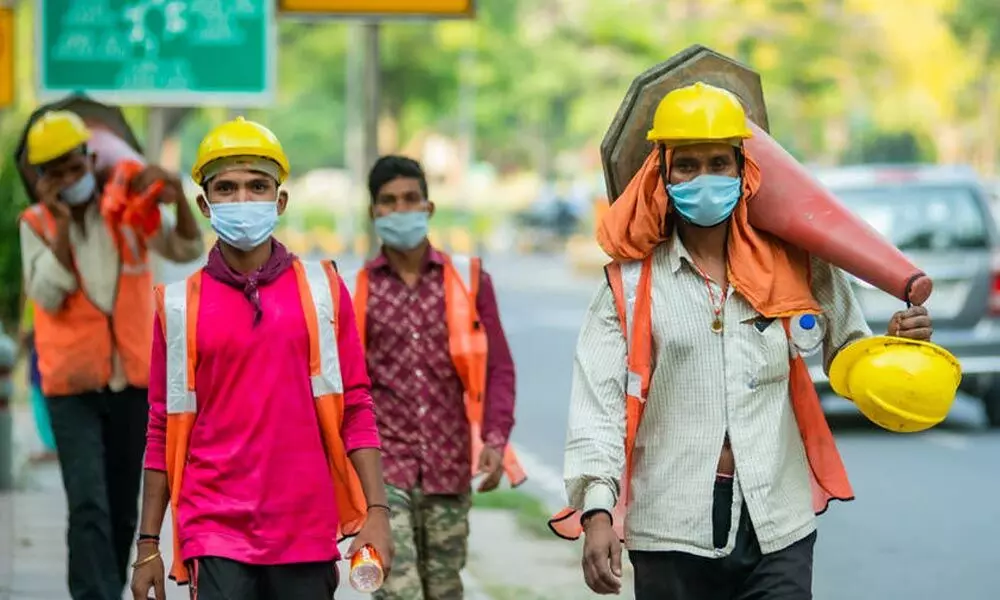India's informal economy shrinks
Plunges to 20% of GDP from a high of 52% in FY18 as country goes on digital drive
image for illustrative purpose

Faster Formalisation of Economy
- Informal economic activity is not specifically defined
- Globally accepted statistical framework of measuring informal economy is still awaited
- Informal economy is estimated at 20% of Europe's GDP
- E-Shram, first-ever national database of unorganised workers, is a big step towards the formalisation of employment
Pandemic-induced gig economy narrows down share of the informal sector to just 20% in 2021 from 52.4% in 2018
Formalisation of an economy is always better from a policy perspective. Our estimates show that 11.4 crore taxpaying households, 8.5% of the total population, contribute to Rs 75 lakh crore or 65% of the private final consumption expenditure and cross subsidises 91.5% of the population, says SBI group's chief economic advisor, Dr Soumya Kanti Ghosh
Mumbai: Share of the informal economy shrank to 20 per cent in 2021 from a high of 52 per cent in the 2017-18fiscal year, says a study.
As per the report by SBI's research team, there is a need to support honest taxpaying households through a better designed tax structure, particularly indirect taxes on items like fuel.
A large chunk of the total workforce in India earns its livelihood fromthe informal sector. Though the pandemic has led to huge devastating impact on all the sectors of the economy, the toll was much higher on the informal sector. While, the formal sector is almost now back to its pre-pandemic level, the informal sector still continues to bear the brunt. In this context, India's estimate done as of FY2018 suggests the size of informal economy at 52 per cent of the economy. This number was expressed by NSC, says the findings of an internal research by SBI.
Even globally informal economic activity is not specifically defined. Given existing GDP measurement dispensations worldwide, it is a challenging task to measure informal economy. As such a globally accepted statisticalframework of measuring informal economy is still awaited. However, a sizeable informal economy is not just the issue of emerging and developing economies. For example, as per IMF, even in Europe, informal economy is estimated at 20 per cent of GDP. For India, post 2016, plethora of measures accelerated digitisation of the economy, leading to the emergence of gig economy which facilitated higher formalisation of the Indian economy - at rates possibly much faster than most other nations.
As per the study, it is estimated that the shrinkage in economy post pandemic is mostly informal.Hence, the loss in output across sectors gives a measure of the informal sector. Accordingly, it is estimated that the informal economy is possibly is at max 15 per cent-20 per cent of the GDP. There is wide variation across sectors, though, with formal sectors like finance and insurance expanding post pandemic.
The Government has made many efforts for formalisation in the last couple of years. For example, one of the sources to analyse the extent of formalisation is the monthly EPFO payroll report which provides data on establishments remitting first ECR (Electronic Challan-cum-Return) in a particular month. Based on this data,it is estimated almost 36.6 lakh jobs have been formalised till August 2021.
Next is the E-Shram portal, which is the first-ever national database ofunorganised workers. 5.7 crore unorganised workers (Oct 30/ and counting) have registered in the first two months after its launch, with 62 per cent of workers belonging to the age-group of 18-40 years and 92.0 per cent registered workers having monthly income of less than Rs 10,000. State wise data shows that top fourStates accounted for 72 per cent of total registration, with West Bengal on the top followed by Odisha and Uttar Pradesh. Occupation wise, workers fromagriculture sector account for 55 per cent of registration followed by construction sector (13 per cent). Of the 5.7 crore registered workers, 81.2 per cent or 4.6 crore have bank accounts, but only 24 per cent of them or 1.1 crore workers have Aadhaar linked bank accounts.
The E-Shram is a big step towards the formalisation of employment as the study indicates that till date the rate of formalisation of unorganisedlabour due to E-Shram is around 17 per cent / Rs 6.8 lakh crore / 3 per cent of GDP in just two months. Even in agriculture, the usage of KCC (Kisan Credit Card) has increased significantly and through this rate, formalization of Rs 4.6 lakh crore happened.
The total number of insurance and pension accounts that have been opened across several schemes for the unorganised as well as organised is as much as 68.9 crore.
"Formalisation of an economy is always better from a policy perspective. Our estimates show that 11.4 crore taxpaying households, 8.5 per cent of the total population contributes to Rs 75 lakh crore or 65 per cent of the private final consumption expenditure and cross subsidises 91.5 per cent of the population," says SBI group's chief economic advisor, Dr Soumya Kanti Ghosh.
Hence it is important and ethical that even as we formalise, we must support honest taxpaying households through a better designed tax structure, particularly indirect taxes on items like fuel, he added.

